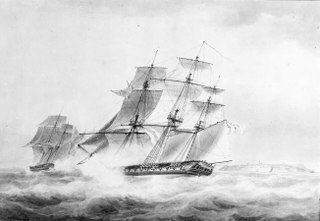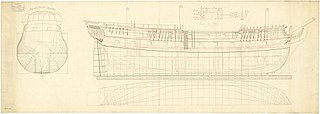Royal Navy
Hobart served on the East Indies Station and on 1 October 1795 was under the command of Captain Benjamin William Page. She then carried a detachment of the 52nd Regiment of Foot, commanded by Captain Charles Monson, which took possession of Molletive, Ceylon. [3]
In early 1796 Rear-admiral Peter Rainier led a squadron composed of HMS Suffolk, Centurion, Resistance, Orpheus, and Swift to attack Dutch possessions in the Banda or Nutmeg islands. One or two armed ships belonging to the British East India Company, and three transports carrying troops completed the expedition. [4]
On 16 February the British arrived off Amboyna, the Dutch capital of the Molucca islands. The troops landed and took possession of the island. The treasury contained 81,112 rixdollars, and the warehouses contained 515,940 lbs. of cloves. [4]
On 5 March the expedition arrived off Great-Banda, or Banda-Neira. The troops landed on the 8th after a little resistance from two small shore batteries. That evening Fort Nassau surrendered. The treasury at Banda-Neira held 66,675 rixdollars, and the warehouses held 84,777 lbs. of nutmeg, 19,587 lbs. of mace, and other stores. Each of the British naval captains about £15,000 sterling in prize money. Although Hobart had performed a valuable service prior to the captures, she did not share. [4]
Rainier had had Captain Page and Hobart led the expedition through the straits of Malacca, Sincapore, and Banca because of Page's familiarity with the area. However, after the capture on 22 January in the straits of Banca of the brig Harlingen with important dispatches, Rainier had Hobart carry them to Madras. Because she was not at the capture, she did not share in the prize money. [4] [lower-alpha 1]
Page was formally appointed as Hobart's commander in April 1796. In December command of Hobart passed to Commander George Astle. Commander James Hills succeeded Astle in December 1797, and he was in turn succeeded by Commander Volant Vashon Ballard in July 1798. Commander Charles Elphinstone took over in August 1799, and commanded Hobart until being succeeded by Commander Francis Stratton in June 1800. In 1801 she was under Lieutenant Robert Evans, at first in an acting capacity, until his promotion to commander in April 1802.
USS Delaware was a 24-gun sailing frigate of the United States Navy that had a short career in the American Revolutionary War as the British Royal Navy captured her in 1777. The Royal Navy took her in as an "armed ship", and later classed her a sixth rate. The Royal Navy sold her in 1783. British owners named her United States and then French interests purchased her and named her Dauphin. She spent some years as a whaler and then in March 1795 she was converted at Charleston, South Carolina, to French privateer. Her subsequent fate is unclear.
HMS Victorious was a 74-gun third rate ship of the line of the Royal Navy, launched at Blackwall Yard, London on 27 April 1785. She was the first ship of the Royal Navy to bear the name.

HMS Suffolk was a 74-gun third-rate ship of the line of the Royal Navy, launched on 22 February 1765 at Rotherhithe. She was designed by William Bateley, based on the principles of his earlier HMS Fame, and was the only ship built to her draught.

HMS Phoenix was a 36-gun Perseverance-class fifth-rate frigate of the Royal Navy. The shipbuilder George Parsons built her at Bursledon and launched her on 15 July 1783. She served in the French Revolutionary and Napoleonic Wars and was instrumental in the events leading up to the battle of Trafalgar. Phoenix was involved in several single-ship actions, the most notable occurring on 10 August 1805 when she captured the French frigate Didon, which was more heavily armed than her. She was wrecked, without loss of life, off Smyrna in 1816.

HMS Cormorant was a 16-gun ship sloop of the Cormorant class in the Royal Navy, launched in 1794 at Rotherhithe. She captured four French privateers before an accidental fire destroyed her in 1796.

HDMS Lougen was a brig of 18 guns, launched in 1791, and the name-vessel of her class of six brigs designed by the naval architect Ernst Stibolt. She was the first Danish warship to be copper-sheathed. She was active protecting Danish merchant shipping and suppressing pirates in the Mediterranean and in the Caribbean. In March 1801, she fought off the British privateer Experiment and the 22-gun warship HMS Arab in a single action. When the British captured the Danish West Indies in 1801, Lougen was part of the booty. The British later returned her to Denmark where she was broken up in 1802.
HMS Amboyna was the Dutch brig Harlingen, which the British captured in the East Indies in 1796. They renamed her Amboyna after their recent capture of Ambon Island. She then served briefly in the Royal Navy before she was broken up in 1802.

The Invasion of Ceylon was a military campaign fought as a series of amphibious operations between the summer of 1795 and spring of 1796 between the garrison of the Batavian colonies on the Indian Ocean island of Ceylon and a British invasion force sent from British India. The Dutch Republic had been a British ally during the French Revolutionary Wars, but was overrun by the French Republic in the winter of 1794 and reformed into the client state of the Batavian Republic. The British government, working with the exiled Stadtholder William of Orange, ordered the seizure of Batavian assets including colonies of the former Dutch Empire. Among the first territories to be attacked were those on the coast of the island of Ceylon, with operations initially focused on the trading port at Trincomalee.

The Battle of Île Ronde was a minor naval engagement between small French Navy and British Royal Navy squadrons off Île de France, now named Mauritius, in the early stages of the French Revolutionary Wars. The battle was fought over control of the waters around Île de France, which was under blockade from the British squadron as French warships and privateers operating from the island posed a significant threat to vital British trade routes connected to British India and China.
HMS Musquito was a 4-gun schooner, previously the French privateer Vénus. The Royal Navy captured her in 1793, and purchased her in 1794. Because there was already a Venus in service, the navy changed her name to Musquito. During her brief service Musquito captured an armed vessel that appears to have out-gunned her.

The East Indies theatre of the French Revolutionary Wars was a series of campaigns related to the major European conflict known as the French Revolutionary Wars, fought between 1793 and 1801 between the new French Republic and its allies and a shifting alliance of rival powers. Although the Indian Ocean was separated by vast distance from the principal theatre of the conflict in Western Europe, it played a significant role due to the economic importance of the region to Great Britain, France's most constant opponent, of its colonies in India and the Far Eastern trade.

HMS Barbuda was commissioned into the Royal Navy in 1780 after having briefly served as an American privateer. Barbuda was one of the two sloops that captured Demerara and Essequibo in 1781, but the French Navy captured her there in 1782 and took her into service as Barboude. The French Navy sold her to private owners in 1786, and she served briefly as a privateer in early 1793 before the French Navy purchased her again and named her Légère. She served them until mid-1796 when the Royal Navy captured her and took her into service as HMS Legere. She was wrecked off the coast of Colombia, without loss of life, in February 1801.
His Majesty's hired armed vessel Marechal de Cobourg served the British Royal Navy under contract during the French Revolutionary Wars. Contemporary records also referred to her as Marshall de Cobourg, Marshall Cobourg, Marshall Cobourg, Marquis Cobourg, Marquis de Cobourg, Cobourg, Coborg, and Saxe Cobourg. Further adding to the difficulty in tracking her through the records, is that although she was originally a cutter, later the Navy converted her to a brig.
HM hired armed cutter Flora served the British Royal Navy under contract from 16 August 1794 until a French privateer captured her on 1 December 1798.

The invasion of the Spice Islands was a military invasion by British forces that took place between February to August 1810 on and around the Dutch owned Maluku Islands also known as the Spice Islands in the Dutch East Indies during the Napoleonic wars.
HMS Trompeuse was a former French 16-gun brig-sloop, launched in July 1793, that HMS Sphinx captured on 12 January 1794 near Cape Clear Island. The British Royal Navy took her into service. As HMS Trompeuse she captured a small privateer and then grounded off Kinsale in 1796.

HMS Albacore was launched in 1793 at Rotherhithe. She captured several privateers ad a French Navy corvette before she was sold in 1802.

HMS Caroline was a 36-gun fifth-rate Phoebe-class frigate of the Royal Navy. She was designed by Sir John Henslow and launched in 1795 at Rotherhithe by John Randall. Caroline was a lengthened copy of HMS Inconstant with improved speed but more instability. The frigate was commissioned in July 1795 under Captain William Luke to serve in the North Sea Fleet of Admiral Adam Duncan. Caroline spent less than a year in the North Sea before being transferred to the Lisbon Station. Here she was tasked to hunt down or interdict French shipping while protecting British merchant ships, with service taking her from off Lisbon to Cadiz and into the Mediterranean Sea. In 1799 the ship assisted in the tracking of the French fleet of Admiral Étienne Eustache Bruix, and in 1800 she participated in the blockade of Cadiz.

HMS Resistance was a 44-gun fifth-rate Roebuck-class ship of the Royal Navy launched in 1782. Based on the design of HMS Roebuck, the class were built for use off the coast of North America during the American Revolutionary War. Commissioned by Captain James King, Resistance served on the West Indies Station for the rest of the war. She captured the 24-gun corvette La Coquette on 2 March 1783 and then went on in the same day to participate in the unsuccessful Battle of Grand Turk alongside Horatio Nelson. Resistance then went for a refit in Jamaica, during which time King fell ill and was replaced by Captain Edward O'Bryen. O'Bryen commanded Resistance until March 1784 when she was paid off. In 1791 she was recommissioned as a troop ship, but was converted back into a warship in 1793 at the start of the French Revolutionary War, under Captain Edward Pakenham.
Morgan Rattler was probably a French vessel launched under another name and taken in prize early in 1793 after the outbreak of the French Revolutionary Wars. She became a Liverpool privateer, but was quickly captured. A few years later she became a French privateer. She captured several British merchantmen before a British naval brig captured her and her prizes.











